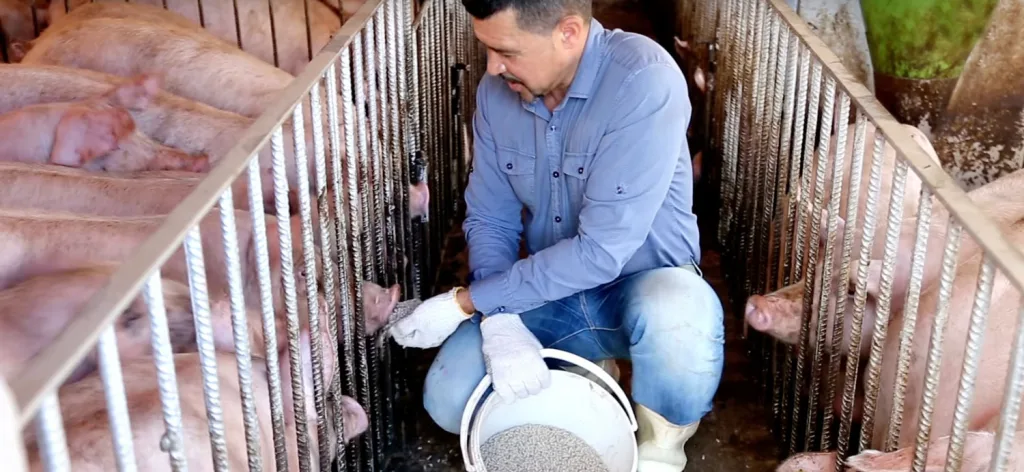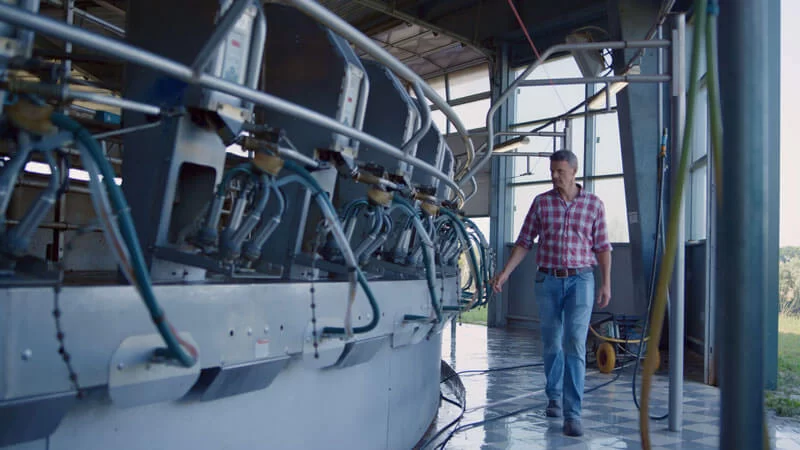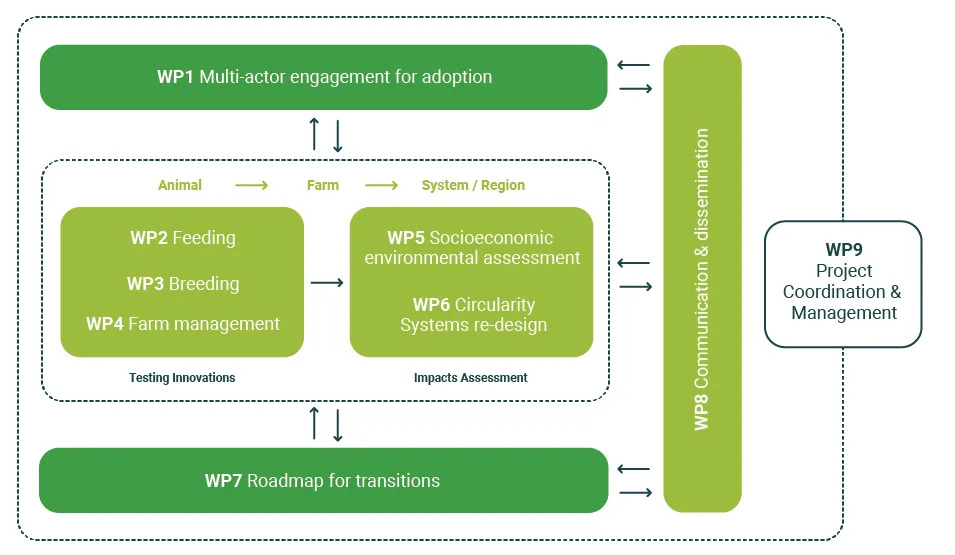
About Re-Livestock
The overall objective of Re-Livestock is to understand and mobilize adoption of innovative practices, applied cross-scale (animal, herd/farm, sector and region), to reduce the greenhouse gas (GHG) emissions of livestock farming and to increase the capacity for dealing with climate change impacts, in order to ultimately increase the overall resilience of the livestock sector.
To reach this aim, the consortium has brought together scientific excellence and technical expertise, from across Europe and disciplines, to develop novel and scientifically supported integrated approaches targeted to different livestock systems and geographic regions in the context of climate change.
Strong collaboration with industry stakeholders and partners to identify the innovations and to co-design their validation will ensure relevance and will maximise the adoption of best practices.
National case studies and stakeholders forums, together with a European multi-actor platform, will allow for an engaged co-design of transition pathways by using unique food system models, whilst innovative experimental work will allow for the testing and sharing of the latest innovative solutions.
An ambitious communication strategy will extend the multi-actor approach to a broad range of stakeholders to create a community of practice.
Objectives
- To improve the sustainability of feeding resources for livestock across European regions.
- To accelerate the development and application of new breeding tools and strategies to achieve permanent and timely reductions in GHG emissions and adaptation to climate change.
- To evaluate system specific farm-level husbandry practices to reduce net GHG emissions and increase adaptation to different scenarios.
- To refine and apply innovative holistic farm-scale environmental and socio-economic assessment tools to enhance the adoption of the practices.
- To enable the resilience of livestock production systems today and in the future under different climatic scenarios from regional to global scale by adopting innovations based on circularity principles.
- To design action-based pathways for the transition towards resilient livestock farming systems.
- To understand the factors influencing the adoption and efficacy of mitigation and adaptation practices with multi-actor engagement.
Ambition
Despite the extensive research of farming practices to enhance mitigation and adaptation to climate change, livestock farming systems continue to move on unsustainable trajectories through a focus on “highly tangible, but essentially weak, leverage points” caused by several technical and adoption-related limitations (Rosset et al., 2011; Dumont et al., 2014).
There are, however, numerous opportunities to increase livestock farming resilience through better knowledge on:
- C footprint of feed materials and alternative sources (i.e. by-products)
- Efficacy of mitigation feed additives across different production systems
- How climate change is affecting growth and utilization of grasslands
- The impact of integrating mitigation and adaptation goals in livestock breeding programs across a range of breeds
- The impact of combining different farm level practices with support of modern technologies in different production system
- The impact of the innovations across scales/levels (temporal, spatial and organizational)
- How to operationalize the transition to a more resilient livestock sector.
The ambitious studies in Re-Livestock will serve to address and exploit these opportunities through:
- Regional-specific integrated assessment of mitigation and adaptation practices
- Refining existing tools and models for a holistic evaluation of current and future livestock systems
- Determining the role of livestock in supporting circularity
Project concept
Re-Livestock proposes a holistic approach based on the ‘Re-Concept’, by Re-Framing climate change action in livestock systems through:

- Re-Evaluation of feeding inputs and nutrients cycling
- Re-Exploring animals’ adaptive capacity to integrate mitigation and adaptation
- Re-Design of livestock systems
Work packages
Re-Livestock proposes a holistic approach based on the ‘Re-Concept’, by Re-Framing climate change action in livestock systems through:

WP1 will build and support local stakeholder forums (sub-national/national/international) to guide and support the co- innovation processes of the project and ensure that the voices of all key stakeholders (including farmers, farmers groups, food processors, feed companies, livestock breeding companies, advisory and research services, local communities, citizens, civil society organisations including NGOs, and government representatives) are captured, in order to ensure that the project results can be readily implemented in practice and exploited. The stakeholder forums will identify and support case studies for understanding the factors influencing the adoption and efficacy of mitigation and adaptation practices. WP1 will also establish a Reflexive Learning for Innovation Network for stakeholders to review project outcomes and processes from WPs 2-7. To ensure that local/national level learnings are considered at a macro (EU) level, a series of stakeholder consultations through a European multi-actor platform will operate concurrently over the life of the project and continuously draw on the lessons emerging from the local stakeholder forums.
WP2 recognises the potential to mitigate livestock emissions by making greater use of feed materials with low C footprint. Many of these will be local (i.e. different products in different regions), co-products from food industry and non-human edible. Some (e.g. insects) will be novel. Feeds with low C footprints will be evaluated by laboratory, in vitro and in vivo experiments, using methods harmonised across project partners and relevant to models used to formulate modern livestock diets. WP2 also recognises that future ruminant livestock systems will be based on multispecies grasslands that deliver a range of ecosystem services, such as biodiversity, soil C sequestration and recreational use, as well as nutrition. Learning how to make best use of such grasslands – which will vary geographically – is an important component of WP2, as well as assessing how to integrate new CH4 mitigating feed supplements that will enter the market during the lifetime of the project. WP2 will also explore the impact of climate change on aspects of the feed supply chain (including grasslands) and on the health, welfare and performance of livestock (specifically nutritional means to enhance their heat tolerance).
WP3 defines traits at animal level for mitigation of and adaptation to climate change. Mitigation traits will focus on CH4and CO2emissions of dairy and beef cattle, whereas adaptation traits will focus on changes in (re)production performance of cattle and pigs related to weather conditions. Increased knowledge of the underlying biology of these traits will be realised by metabolomics and transcriptomics data collected on cattle and pigs during experiments. Novel genetic evaluation models will be developed by incorporating systems biologyand machine learning. Breeding strategies will be set up to secure genetic improvement of the next generation of livestock, so that they meet the future requirements of the EU Green Deal and the Farm2Fork policy.
WP4 will assess abroad set of farm level management alternatives. Housing conditions will be modified to mitigate heat stress conditions in intensive cattle and pigs systems, improving system efficiency and reducing emission intensity. Techniques aimed to reduce manure emissions during the whole management chain will be also explored, promoting nutrient recycling and C sequestration. Agroforestry systems will be redesigned to optimize production efficiency while promoting C sequestration. Trials across different climatic regions will be developed, assessing environmental impacts, animal welfare and system performance as indicators in collaboration with WP5. Data obtained from individual animal monitoring using PLF will be used to develop algorithms aimed to help farmers on herd decision making under mitigation and adaptation constraints.
WP5 focuses on the assessment of farm level environmental and economic performance, aswell as indicators for animal welfare and public goods. Utilising a range of advanced tools, and with the further development of methods to quantify C sequestration; model and real farm systems will be assessed to develop baseline and future scenarios. The efficiency and resilience of innovative technologies tested in WP2, 3 and 4, will be explored to determine their mitigation and adaptation capacity to develop improved systems. Animal welfare indicators that focus on impacts of a changing and changeable climate will be advanced, for integration into decision support tools. The rapidly advancing field of farm system resilience is still in its infancy but will be explored through assessment of case study farms, to better understand the factors that provide improved resilience and transformability. To enable improved adoption of innovations at the farm level, a portfolio approach will be taken to adapt and widen access to the Re-Toolbox of leading sustainability and carbon footprint tools.
WP6 creates a model suite (Re-Model) to define possible redesigns of livestock production systems within a circular bio-economy. It first links the CiFOS model to the LPJmL model that will provide future biomass under the newest generation of climatic scenarios with improved climatic modelling. Then CiFOS will be linked to the Livestock Spatial Allocation Model (LSAM) that is under development for Europe inspired by the CLEANED approach allowing a spatially explicit impact assessment of nutrient, carbon and water ecological cycles. This model suite will explore how practices and innovations tested in WP1-4 can be combined to enhance circularity of the European livestock sector with the aim to respect climate boundaries and enhance the resilience of the food system. Additionally, CiFOS-LPJmL combination will be run globally to assess the impact of circularity in Europe on food security and feed and fodder availability in the rest of the world.
WP7 adopts a systemic approach to describe potential adaptation and mitigation scenarios for the European livestock farming systems. The WP identifies farmers adoption of the innovations and defines action-based priorities and processes to mobilise the transition towards the Green Deal and Farm2Fork objectives. This WP applies a combination of qualitative and quantitative methods and relies on a multi-actor participatory approach to analyse current European livestock farming systems and co-define actions-based socio-economic, governance and institutional priorities and roadmaps in support of the transition towards a fair, healthy and resilient European livestock farming system in support of the Farm2Fork strategy. Stakeholders are directly involved in data collection, validation of methods and outcomes following an interative participatory approach in close collaboration with WP1.
WP8 will extend the expected impacts of Re-Livestock beyond the project lifespan and help support the uptake of project results and outputs by the relevant sectors by supporting the creation of a community of practice with WP1. Activities will increase awareness, knowledge and insight on Re-Livestock research and results targeting scientists, cattle and pig breeding organisations, feed and feed additive companies, animal health professionals, farm managers and advisors, farmers, policy makers, food industry, consumers and society in general. WP8 will
i) develop and update a detailed dissemination and communication plan,
ii) disseminate and communicate the project’s results outside of the consortium,
iii) interact with EIP-AGRI platform and other on-going H2020, HEurope and international projects,
iv) ensure scientific communications at congresses or through publications,
v) outreach to farming, advisory and policy groups through adapted dissemination materials and activities and
vi) deliver training on the utilisation of innovative practices and knowledge developed to early career scientists and professionals.
WP9 manages the strategic steering, project monitoring, risk assessment, operational daily management, internal communication, administrative and financial management, reporting to the EC and management of intellectual property and data generated by the project in terms of protection and access (via the Consortium Agreement and Data Management Plan). Ethics issues will be handled by all partners following strict procedures supervised by the Executive Board of the project. In addition, an expert in ethics will act as an observer to ensure all ethics issues are correctly addressed.
WP Leaders
| Name | Entity/Partne | Leader/Co-leader | WP | |
|---|---|---|---|---|
| l.g.smith@reading.ac.uk | Laurence Smith | UREAD | WP Leader | 1 |
| john.newbold@sruc.ac.uk | John Newbold | SRUC | WP Leader | 2 |
| ignacio.fernandez-figares@eez.csic.es | Ignacio Fernández-Figares | CSIC | WP-Co-Leader | 2 |
| rosa.nieto@eez.csic.es | Rosa Nieto | CSIC | WP-Co-Leader | 2 |
| birgit.gredler-grandl@wur.nl | Birgit Gredler-Grandl | WR | WP Leader | 3 |
| luca.fontanesi@unibo.it | Luca Fontanesi | UNIBO | WP-Co-Leader | 3 |
| feresbar@upv.es | Fernando Estelles | UPV | WP Leader | 4 |
| xdiadeo@upv.es | Xabier Díaz de Otálora | UPV | WP Leader | 4 |
| anneg.kongsted@agro.au.dk | Anne Grete Kongsted | AU | WP-Co-Leader | 4 |
| elin.roos@slu.se | Elin Roos | SLU | WP Leader | 5 |
| wolfram.simon@wur.nl | Wolfram Simon | WU | WP Leader | 6 |
| hannah.vanzanten@wur.nl | Hannah van Zanten | WU | WP Leader | 6 |
| catherine.pfeifer@fibl.org | Catherine Pfeifer | FIBL | WP-Co-Leader | 6 |
| michele.moretti@agr.unipi.it | Michele Moretti | UNIPI | WP Leader | 7 |
| lopez-francos@iamz.ciheam.org | Antonio Lopez-Francos | IAMZ-CIHEAM | WP Leader | 8 |
| schlageter@iamz.ciheam.org | Andrés Schlageter | IAMZ-CIHEAM | WP Leader | 8 |
| afale@consulai.com | Alexandre Falé | CONSULAI | WP-Co-Leader | 8 |
| cramos@consulai.com | Carolina Ramos | CONSULAI | WP-Co-Leader | 8 |
| ines.rivelli@eez.csic.es | Ines Rivelli | CSIC | WP Leader | 9, 10 |
| veronica.verdejo@eez.csic.es | Veronica Verdejo | CSIC | WP Leader | 9, 10 |
| david.yanez@eez.csic.es | David Yanez-Ruiz | CSIC | WP Leader/Project coordinator | 9, 10 |